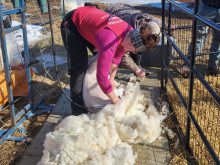VERNON, B.C. – In central B.C.’s sunny Okanagan where heat-loving, sun-worshipping plants are common, a growing number of black sheaths are spreading across the hillsides to protect British Columbia’s newest crop from heat and bright light.
This is ginseng country, where the lucrative cash crop could be worth as much as $130 per kilogram ($60 per pound).
For former schoolteacher Al Smith of Vernon, ginseng farming spells freedom from the daily grind of the classroom. He’s been in the business eight years and each season he plants more acres. He has harvested four crops so far.
Read Also

Charges laid after cattle theft
Saskatchewan RCMP lay two charges against a man after six cattle went missing.
As president of the Associated Ginseng Growers of B.C., he sets time aside from farm duties to write a column for the organization’s newsletter and to travel so he can share what he has learned about this unusual perennial root crop.
There are about 120 producers growing ginseng on 1,500 acres in B.C.
Ginseng is indigenous to the North American East Coast where it grows wild in deciduous forests that provide the necessary shade, said Smith.
Tender loving care
As a beginning grower with a large investment, Smith said his first crops were nurtured and carefully watched around the clock.
He encourages growers to start with an acre.
“It’s a good idea with a crop like this to get in on your hands and knees and do a lot of the work yourself, so on a small scale you make your mistakes and learn from them on a small scale instead of a large scale.”
As well, he cautions it’s no get-rich-quick scheme. It takes time, patience and a large investment of money.
Besides the roots, Smith also produces ginseng seed which he sells all over Canada. Growers in Alberta and Saskatchewan have expressed interest in his plants and Smith is interested in discovering whether this perennial will survive a prairie winter.
“We’re going to know within the next two or three years how they’re doing,” he said. A long as they follow all the basic ginseng growing techniques the roots shouldn’t winter kill although prairie yields probably won’t exceed 675 kilograms per acre (1,500 pounds) compared to 1,300-2,300 kg per acre (3,000 to 5,000 pounds) possible in B.C.
Vernon is ideal for ginseng production with its hot summers, mild winters and sloping land necessary for good drainage.
Ginseng, valued for its roots, takes four years to mature. Similar to a parsnip in appearance, the root is creamy colored and should develop forks that resemble human arms and legs.
It’s a touchy plant that doesn’t mature beyond a few leaves in its first year of life.
Seeds are planted in wide, raised beds and covered with dirt and a straw mulch. Some irrigation is done and the plants must be protected from heat stress with black polypropylene shade cloths that block about 75 percent of the sunlight. Each year the plant becomes bushier and produces the large tap roots desired by Asian customers. Each growth stage requires different care.
Harvest can start when plants are three years old if someone fears disease will kill a young crop and wipe out two or three years worth of work, Smith said.
Ginseng is sold as a dry or fresh root and is used as a medicine or health food. It can be sold in almost any form including an additive to soft drinks in China. Asian herbalists and medical experts claim that taken regularly, it reduces stress, increases stamina, controls blood sugar and cholesterol levels, improves metabolism and increases longevity.
Taiwan is major market
B.C. growers are shipping their roots to Canadian Chinatown markets and health food stores. Most is shipped to Taiwan.
This year, besides expanding his acreage, Smith is building a drying and processing facility on his farm to handle his crop and his neighbors’ as well. There will be storage bins, special washing facilities and drying equipment.
When B.C. farmers started in 1982 most work – weeding, picking seeds, spraying – was done by hand. Now most have special equipment to reduce the work load. There is also machine sharing among the growers and Smith sees the possibility of a secondary industry springing up where custom operators can handle seeding and harvest.
Most producers have modified their farm equipment to travel up and down rows. Machine wheels need to be about two metres (6.5 feet) apart and tractors must be low enough to pass beneath the shade cloth that remains over each field throughout the growing season. A special harvesting machine is also required to lift the roots from the bed without cutting or bruising them.
Many of the inventions and modifications are shared among growers. In B.C. there is a friendly exchange of tips to make a better ginseng garden.
“The guys who are going to make it are the ones who are out there circulating and finding out from the older growers what’s happening,” Smith said.

















